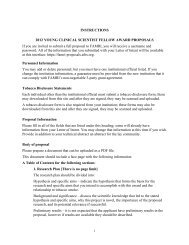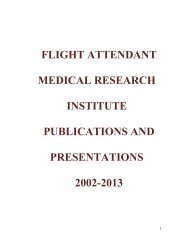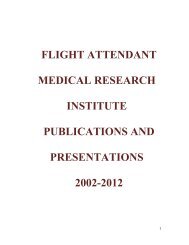MISSION
2009 compendium of FAMRI-supported research - Flight Attendant ...
2009 compendium of FAMRI-supported research - Flight Attendant ...
Create successful ePaper yourself
Turn your PDF publications into a flip-book with our unique Google optimized e-Paper software.
among men exposed to cigarette smoke. Dr. Foster and colleagues hypothesize that cigarette smoke<br />
impairs the production of selenium containing proteins—called selenoproteins. The aim of their research is<br />
to characterize pathways that regulate selenoprotein production. Perhaps by augmenting selenoprotein<br />
production efficiency or by enhancing the stability of selenoprotein messenger RNAs it will be possible to<br />
increase the selenoprotein content of cells and afford protection against cellular sources of oxidative stress<br />
and toxins such as cigarette smoke. To characterize cellular signaling pathways regulating selenoprotein<br />
production and stability, their laboratory has developed two novel reporter assays. One reporter measures<br />
how efficiently the amino acid selenocysteine is incorporated into an artificial selenoprotein. The other<br />
reporter measures the stability of an artificial selenoprotein. Using these reporters, they have gained preliminary<br />
data that selenoprotein production efficiency is regulated by the phosphoinositide-3 kinase -protein<br />
kinase B (PI3K-AKT pathway). In the presence of selenium, inducers of the PI3K pathway, such as the<br />
cytokine IL-13, enhance L-seryl-tRNA (SEC) incorporation efficiency, increase the level of the antioxidant<br />
selenoprotein glutathione peroxidase 1, and protect HEK293 cells against hydrogen peroxide or cigarette<br />
smoke induced cell death. It is known that under selenium-limiting conditions that some selenoprotein<br />
messenger RNAs (mRNAs) are degraded by a cellular surveillance pathway called nonsense-mediated decay<br />
(NMD). To characterize the mechanisms by which GPX1 mRNA avoids NMD in the presence, but not in<br />
the absence of selenium, Dr. Foster and colleagues are using the second reporter to characterize signaling<br />
pathways that promote the degradation of selenoprotein mRNAs under conditions of selenium deficiency.<br />
In contrast to HEK293 cells, supplemental selenium does not afford PCa cells enhanced protection against<br />
inducers of oxidative stress. They will use their reporter assays and knowledge of the signaling pathways<br />
that regulate selenoprotein production to further characterize the mechanisms by which cigarette smoke<br />
contributes to PCa and to define whether selenoprotein production pathways are impaired in PCa cell<br />
lines.<br />
SMALL PEPTIDE THERAPY ON METASTATIC PROSTATE CANCER<br />
Jer-Tsong Hsieh, PhD; University of Texas Southwestern; CIA 2008<br />
Prostate cancer (PCa) is the most common type of cancer found in American men, other than skin cancer.<br />
Although smoking was unrelated to overall PCa incidence, a prospective study indicates that current<br />
smokers and recent quitters were at higher risk for distant metastatic PCa and fatal PCa. Currently, androgen<br />
ablation is the most effective regimen for distant metastatic PCa, over a period of time, the progression<br />
to life threatening androgen independent (AI) status is inevitable. For the AI disease, there are not<br />
many treatment options currently available with curative outcomes. Therefore, there is an immediate need<br />
to develop a new course of therapy that may hold significant promise for a better cancer control and<br />
improve the life qualities of patients with advanced diseases.<br />
The ultimate goal of this project is to design a combination molecular therapy.<br />
By employing biochemical techniques, Dr. Hsieh and colleagues intend to analyze the underlying mechanism<br />
of CPP specific uptake by PCa. In addition, they will further improve the stability of CPP by changing<br />
its chemical structure. Based on key functional motifs of several prominent tumor suppressor proteins,<br />
they will synthesize small peptides corresponding to these motifs and examine their effect using several preclinical<br />
animal models.<br />
The small peptide is considered much safer than synthetic chemicals. Moreover, the response of tumor<br />
can be detected by non-invasive molecular imaging techniques in a real-time manner. Thus, the outcome<br />
of this study has an immediate clinical application because the goal of this project is to combine new concept<br />
and state-of-art biotechnology to develop a comprehensive therapeutic regimen for AIPCa patients.<br />
INHIBITION OF HEDGEHOG SIGNALING BY CYCLOPAMINE PRODRUG FOR PROSTATE CANCER<br />
Anirban Maitra, MBBS; The Johns Hopkins University; CIA 2007<br />
Dr. Maitra assumed this project from Saeed R. Khan, PhD. The hedgehog (Hh) pathway plays a critical<br />
role in the development of prostate cancer. The Hh signaling pathway specifies patterns of cell growth and<br />
differentiation during embryogenesis in a wide range of tissues. A role for the Hh signaling in oncogenesis<br />
was first reported in subsets of brain tumors (medulloblastomas) and cutaneous basal cell carcinomas arising<br />
in the context of Gorlin’s syndrome, wherein inactivating mutations in the tumor suppressor gene<br />
PTCH result in constitutive activation of the pathway. Most recently Beachy et al described a new paradigm<br />
of Hh pathway activation in endoderm-derived tumors. It has been demonstrated that inhibition of<br />
Hh signaling by smoothened antagonist, cyclopamine suppresses Hh signaling, down-regulates cell invasiveness,<br />
and induces apoptosis. Thus, targeted inhibition of Hh signaling may have significant implications<br />
of prostate cancer (PCa) therapeutics. Currently there is no curative treatment for men with metastatic<br />
1 3 2 P A G E







